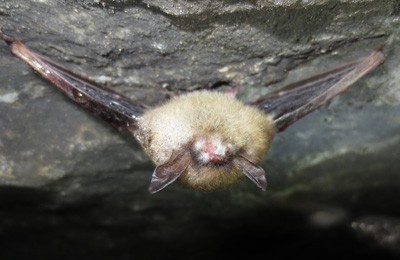Bacteria found naturally on some bats may prove useful in controlling the deadly fungal disease known as white-nose syndrome, which has devastated bat populations throughout eastern North America and continues to spread across the continent. Scientists at the University of California, Santa Cruz, isolated bacteria that strongly inhibited the growth of the white-nose syndrome fungus in laboratory tests.
Experiments are now in progress to see if treating bats with the bacteria can protect them from the disease, said Joseph Hoyt, a UC Santa Cruz graduate student who led the study. “We are analyzing data from tests on live bats now, and if the results are positive, the next step would be a small field trial,” he said.
The results of the laboratory studies were published April 8 in PLoS ONE. Hoyt isolated bacteria from the skin of four bat species and tested the isolates for their ability to inhibit the growth of the fungus. Six bacterial isolates (all in the genusPseudomonas) showed promise and were tested more extensively. All six significantly inhibited growth of the fungus, and two isolates performed especially well in suppressing fungal growth for more than 35 days.
“What’s promising is that the bacteria that can inhibit the fungus naturally occur on the skin of bats. These bacteria may just be at too low a level to have an effect on the disease, but augmenting them to higher abundances may provide a beneficial effect,” Hoyt said.
The researchers hope that a bacterial spray applied to bats during hibernation could suppress the fungus enough to help the bats survive the winter. The fungus that causes white-nose syndrome (Pseudogymnoascus destructans) grows on the exposed skin of bats’ noses, ears, and wings during hibernation, when the bats’ body temperatures drop. Previous research by Kilpatrick’s lab has shown that the fungus can infect nearly every bat in a hibernating colony, but bats that survive the winter are able to clear the infection when they emerge from hibernation and their body temperatures rise.
“The potential for a treatment is exciting, because this disease is raging across the country,” said coauthor Marm Kilpatrick, professor of ecology and evolutionary biology at UC Santa Cruz. Kilpatrick is a wildlife disease expert whose lab has been working with state and federal wildlife agencies and other partners to track the spread of white-nose syndrome, which was first discovered in New York state in 2006.
Four bat species have been hit especially hard by the disease, with some regional populations declining by more than 90 percent. One species in particular, the northern long-eared bat, appears headed toward extinction, Kilpatrick said. “Everywhere the disease has been for a couple of years, this bat is gone. We don’t have any tools right now to protect this species,” he said.
According to Hoyt, the new findings raise the possibility that naturally occurring bacteria could partially explain some of the differences seen in the impacts of the disease on different species. The isolates with the strongest inhibitory properties were cultured from a bat species that has suffered lower mortality from white-nose syndrome than other species. More research is needed, however, to determine if disease severity is related to the bacteria found on wild bats. “This study is just the first step in investigating that possibility,” Hoyt said.
The UC Santa Cruz researchers are part of a coordinated response to white-nose syndrome involving state and federal agencies, universities, and nongovernmental organizations. Kilpatrick and coauthor Winifred Frick, assistant adjunct professor of ecology and evolutionary biology, lead the UCSC team. In addition to Hoyt, Kilpatrick, and Frick, the coauthors of the paper also include UC Santa Cruz graduate students Tina Cheng, Kate Langwig, and Mallory Hee.
This research was funded by grants from the U.S. Fish and Wildlife Service and the National Science Foundation.


